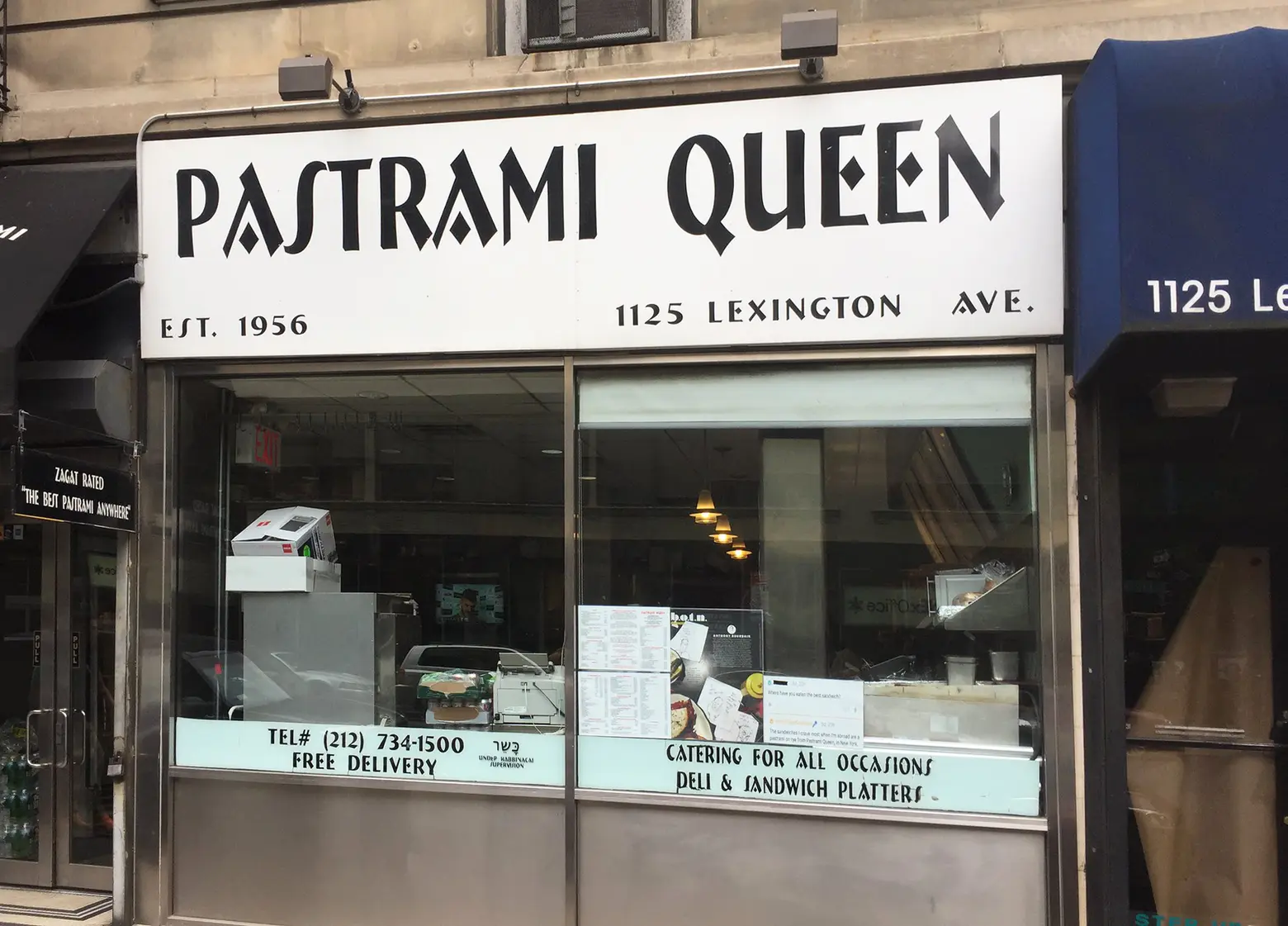
Other than the $1 slice of pizza, a bagel with lox, or a street cart hot dog, is there any food more synonymous with New York City than a pastrami sandwich on rye bread? The classic deli staple has been featured on Seinfeld, Saturday Night Live, and, of course, who can forget that famous scene in Katz’s from When Harry Met Sally? But pastrami’s legacy in the Big Apple began long before these pop culture moments.

By most accounts, pastrami arrived on the Lower East Side sometime between the 1880s and early 1900s, when “some 75,000 Jews left Romania and settled in New York City,” according to Serious Eats. First known in Romania and other Eastern European countries as “pastirma” or “pastrama,” the food was originally made from goose, reports Tasting Table.
However, when Romanian immigrants arrived in the U.S., they found that beef brisket or navel was cheaper and more readily available. They swapped meats and implemented the process of dry-curing it in salt and spices for weeks at a time, and then smoking and steaming it.
At the time, the East Village and parts of the Lower East Side were known as Kleindeutschland, or Little Germany, due to the large presence of German immigrants. So, rumor has it that the word “pastrami” was a mashup of “pastrama” and “salami,” since the foods were being served side by side.
Jewish immigrants also began to establish their own delis, similar to the popular German delicatessens of the neighborhood. Early examples include Katz’s (est. 1905), Lindy’s (1921), and Carnegie Deli (1937). The pastrami sandwiches (which were known as “Roumanian Pastrami” at Lindy’s) were served on rye bread, which was popular in Eastern Europe because it was cheaper than other breads.
Today, very few of these historic delis still exist. But a handful do, and the food has also seen a modern resurgence, even popping up in eggroll form at restaurants like RedFarm. If you’re looking to get your own fill of pastrami, we’ve consulted the pros to put together this list (in no particular order) of the seven absolute best pastrami spots in NYC.
1. 2nd Avenue Deli
Locations: Midtown East + Upper East Side
Pastrami sandwich price: $28.95

2nd Avenue Deli might not be as old as some of its peers, but its story is one for the history books.
Abe Lebewohl immigrated to the East Village in 1950 from Ukraine. He began working in a small deli on the corner of 2nd Avenue and East 10th Street, which he subsequently bought in 1954.
The deli became famous for its menu of Jewish and Ukrainian specialties, pastrami sandwich included, as well as for the Walkway of Yiddish Actors that Lebewohl installed on the sidewalk outside of his restaurant. At the time, this stretch of 2nd Avenue was known as the Yiddish Rialto, the center of the city’s Jewish theater scene that was particularly famous for its vaudeville acts.
As I wrote for Village Preservation’s blog “Off the Grid” back in 2011 (wow, I’m really aging myself here!), “Joe DiMaggio, Bob Hope, Joan Rivers, and Muhammad Ali were just some of the deli’s dedicated customers.” And Lebewohl became a neighborhood fixture, beloved for his charitable acts and community involvement. Sadly, in 1996, “Abe Lebewohl was shot and killed while handling a bank transaction at a neighborhood bank.”
But his legacy lives on: In 2006, 2nd Avenue Deli was forced to close due to rising rents. However, the Walkway of Yiddish Actors remains outside of what is now a Chase Bank (of course). In 2007, 2nd Avenue Deli reopened on East 33rd Street between Lexington and 3rd Avenues, and then an Upper East Side location opened in 2011 on 75th Street and 1st Avenue—and the pastrami sandwich hasn’t gone anywhere.
Ben Gollan, founder of A Man and His Sandwich walking tours, tells 6sqft that the restaurant is among his top pastrami spots.
“You can taste the history with every bite at 2nd Avenue Deli,” he says. “Mountains of pastrami sit alongside plates of pickles. The bread is not the hero of this dish, but you won’t care as that smoked meat slides through your lips.”
Ryan Sutton, the former restaurant reviewer for Eater NY, wrote on his website The Lo Times that 2nd Avenue Deli’s pastrami is “mesmerizing.”
“2nd Ave isn’t the only venue to do a thin cut, but somehow the meat feels thinnest of all here. Each slice weighs as much as a tissue. You don’t chew as much as it disintegrates on the tongue like prosciutto,” he wrote.
“It releases a sweet, beefy musk and packs a restrained level of smoke. The pastrami is more buttery than peppery, and the rye is robust (better than the bread at Katz’s).”
2. Pastrami Queen
Locations: Upper East Side, Upper West Side, Moynihan Train Hall
Pastrami sandwich price: $27

I can’t profess to be a pastrami aficionado like the others cited in this article, but I can tell you that when I lived on the Upper East Side and had a sandwich from Pastrami Queen, the first words out of my mouth were, “This puts Katz’s to shame.”
But don’t take it from me: Anthony Bourdain counted this as one of his two favorite pastrami spots in the city.
And on his personal website, restaurant critic Robert Sietsema delivered a hot take on the fact that Pastrami Queen uses an electric slicer as opposed to hand-slicing its pastrami like Katz’s does.
“At the Queen, the increased surface area that machine slicing produces seems to ramp up the taste, and maybe the whirring blade also liquefies a little more of the fat,” he wrote, calling in the second-best pastrami sandwich in the city and noting its slightly smoky flavor.
Perhaps the bigger selling point here is that the sandwich is served on fresh rye bread from neighboring Orwasher’s Bakery, along with a side of garlicky pickles.
If you visit Pastrami Queen, here’s a fun fact: It originally opened as Pastrami King in 1956 in Williamsburg, Brooklyn. Then, in 1961, it moved to Kew Gardens, Queens, and finally, in 1998, to the Upper East Side, when it changed its name.
3. Moe’s Pastrami & Burger
Location: Prospect-Lefferts Gardens
Pastrami sandwich price: $20-$31, depending on size
Moe’s Pastrami & Burger opened in 2023 on a bustling stretch of Flatbush Avenue in Prospect-Lefferts Gardens.
As GrubStreet explains, the man behind the deli is Fuad “Moe” Hassan, who immigrated to Brooklyn at age 10 from Yemen. In 2015, he started working with his friend at David’s Brisket House in Bed-Stuy, which was then a 70-year-old establishment that had, at some point, “passed hands from the original Jewish owners to Yemeni Muslims” who “stuck with the original lineup of brisket, corned beef, and pastrami recipes that were inherited with the space.”
In 2019, Hassan partnered with the David’s Brisket House team to open Pastrami Masters in East Williamsburg. However, the restaurant closed the following year due to the pandemic. For Hassan, this turned into a blessing, as Moe’s Pastrami & Burger continues to receive rave reviews.
Gollan says the family-run business is “bringing a fresh energy that the city needs.”
“For starters, they offer tiered sizes of pastrami sandwiches (M/L/XL), so that you can devour a sammie and not need a four-hour nap afterwards,” he shares with us. “Additionally, the sandwiches are priced accordingly, so you don’t need to break your bank at the same time as you break your jaw eating this classic dish.”
As for the taste of the sandwich, Gollan says, “A strong flourish of mustard bounces off the tender halal meat at this hidden gem, and the option to toast the bread is very much appreciated!”
4. S&P Lunch
Location: Flatiron
Pastrami sandwich price: $18 (regular) or $26 (bigger)

S&P Lunch is located in the former Fifth Avenue home of the iconic Eisenberg’s Sandwich Shop, which dates to 1929 when Russian immigrant Monas Eisenberg opened it during the Depression to feed his family, according to the original restaurant’s website. For decades, it was a family-run spot where you could grab a seat at the 30-foot-long counter and watch the chefs prepare your food.
The Eisenberg family sold the business in the 1970s, and it changed hands several more times over the years. Sadly, it shuttered for good in 2021 after struggling during the pandemic. In 2022, however, the team from the popular Brooklyn restaurant Court Street Grocers stepped in to revive the sandwich shop, renaming it S&P Lunch.
The new moniker is actually a nod to a little-known fact about Eisenberg’s: It had a one-year stint as S&P from 1928 to 1929. As the Forward explains, Austrian-Jewish immigrants Charles Schwadron and Ruben Pulver opened the restaurant to serve local garment workers.
The new iteration of S&P retains the original marble counter, red vinyl stools, and famous pastrami sandwich.
“The pastrami at S&P… provides a glimpse of what a normal-size sandwich must have been like during its lunch counter heyday,” writes Sietsema. “The pastrami is hand-sliced, and sourced at Old World Provisions in Troy, New York. The sandwich we ate was slightly less fatty than some of the others but emphatically not lean. It feels like eating a sandwich from a century ago.”
However, Gollan recommends opting for the S&P Regular ($20), which features pastrami, cherry peppers, and Russian dressing on a club roll. “That same delicious smoky and fatty pastrami is given a new lease on life in this sandwich,” he writes on his website.
Let’s start with a quick lesson. As far as Jewish-American history is concerned, a delicatessen sells meat products like pastrami and corned beef (prepared in a way that pre-dates refrigeration if you really want to get technical), while appetizing stores sell dairy and fish, such as lox and smoked whitefish. Think Katz’s versus Russ & Daughters.
At Frankel’s, which was opened in 2016 by two local Greenpoint residents, you get the best of both worlds, all with a contemporary twist.
As for the pastrami, you can certainly go with a classic sandwich, but Frankel’s is known for its pastrami, egg, and cheese sandwich served on a challah roll ($15.25). In fact, The New York Times included it in its list of “57 sandwiches that define New York City.”
In reviewing the restaurant, the Times’ Melissa Clark said, “Each mouthful yields just the right combination of silky egg; smoky, gently spiced meat; and melty pulls of American cheese — and it all stays put.”
Gollan, however, is partial to the pastrami reuben ($25.95), which he calls the best such sandwich in the city. On his website, he describes the “blackened pastrami crust” that plays with the meat’s “smoke, salt, and fat.”
He continues, “The additions of tangy sauerkraut, gooey Swiss cheese, and rich Russian dressing on toasted rye are the cherries on top of this pastrami cake.”
6. Liebman’s Deli
Locations: Riverdale, Bronx, and Ardsley, Westchester County
Pastrami sandwich price: $25 (extra lean, $28)

When Joe Liebman opened his Jewish deli in 1953, there were more than 100 Jewish delis in the Bronx. Today, Liebman’s is considered the last such establishment in the borough.
In 1980, Israeli immigrant Joseph Dekel took over the business, preserving the original recipes. His son, Yuval, then took over in 2002 and began baking his own challah bread and babka. And he clearly did something right because in 2014, Anthony Bourdain visited Liebman’s for his show Parts Unknown, when he enjoyed a hot pastrami sandwich and a Dr. Brown’s cream soda.
According to an interview published on The Nosher, Yuval cures his own pastrami and “slices it thin so that slivers of the smoked meat’s dark crust are evenly interspersed on a sandwich.”
But in their list of iconic sandwiches, The New York Times recommends The No. 7 ($29), which is a mouthwatering mass of “layers of thinly sliced pastrami and corned beef topped with rich coleslaw and Russian dressing.”
7. Katz’s Delicatessen
Location: Lower East Side
Pastrami sandwich price: $28.95

The experts are divided as to whether or not Katz’s serves some of the best pastrami in New York City, but one thing that can’t be debated is that this Lower East Side deli is a historic institution.
It got its start in 1888, when the Iceland brothers opened it as a small deli on Ludlow Street called Iceland Brothers, according to the restaurant. In 1903, Willy Katz joined the business, and the name changed to Iceland & Katz. Seven years later, Willy’s cousin Benny helped him buy out the Iceland brothers and officially changed the name to Katz’s Delicatessen.
Finally, in 1917, the deli moved across the street to its current location. “The vacant lot on Houston Street was home to barrels of meat and pickles until the present storefront facade was added between 1946-49,” Katz’s explains.
Over the years, Katz’s became famous for its Friday night franks and beans dinners (a bygone tradition), its “send a salami to your boy in the army” program that was established during WWII (and remains today), and the fact that the pastrami takes a full 30 days to cure in a secret brine. After that, it is hand rubbed with spices, slow-smoked for three days, and finally boiled for three hours.
But how does that sandwich stack up against the rest on this list?
In a positive 2022 review of S&P, The New York Times food critic Pete Wells noted that Katz’s pastrami sandwich “is not fantastic and never will be until something is done about the rye.” He doubled down in the sandwich list, calling it “bland, flimsy rye that would probably fall apart even if it weren’t tasked with holding a hot stack of cured meat the size of an armadillo.”
Sietsema, on the other hand, counts it as the absolute best pastrami in the city: “Both parts of the brisket are used, resulting in the correct relationship of lean meat to fatty, and the cure has been perfected for a century and more,” he writes.
And perhaps most importantly, the late Anthony Bourdain also counted it as one of his favorites.
At the end of the day, as Wells concluded, “Pastrami ordered and eaten at Katz’s is both a meal and a ceremony, one that can turn tourists into New Yorkers and New Yorkers into tourists.”








Recent Comments